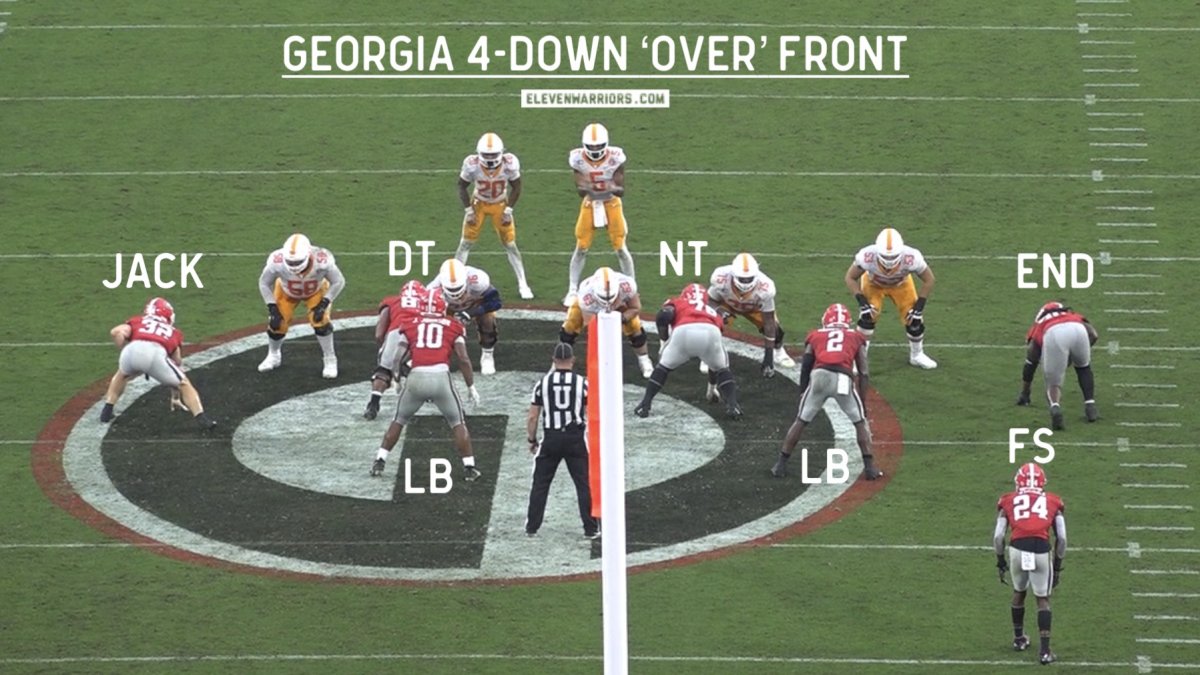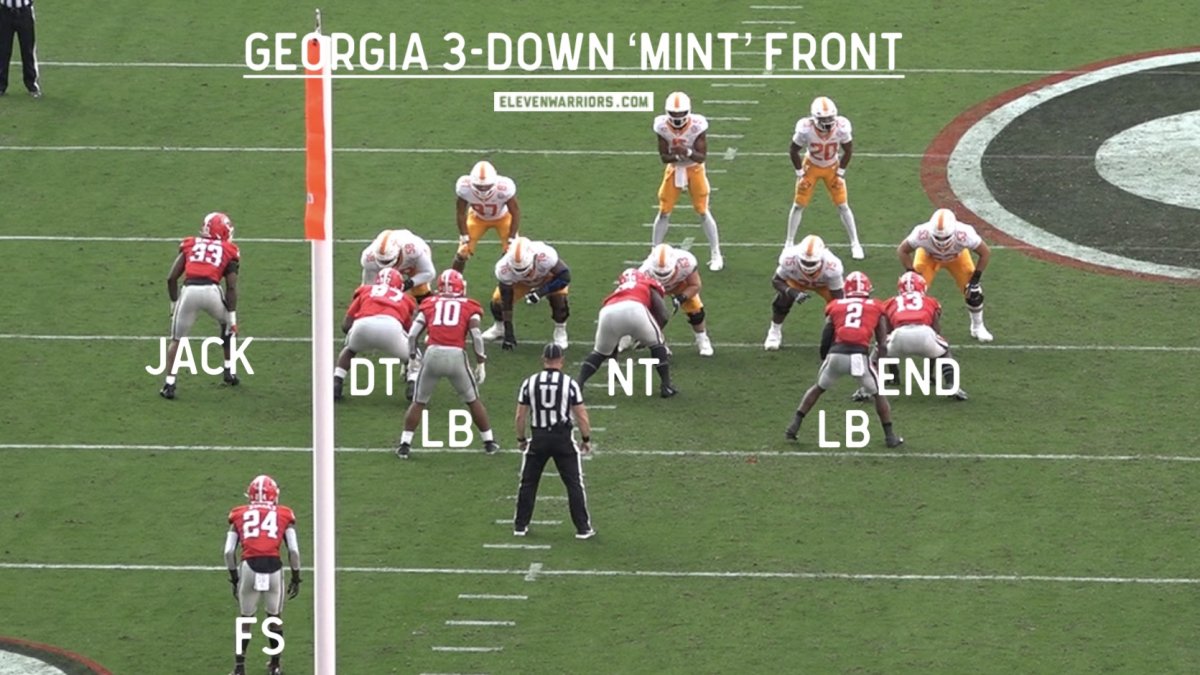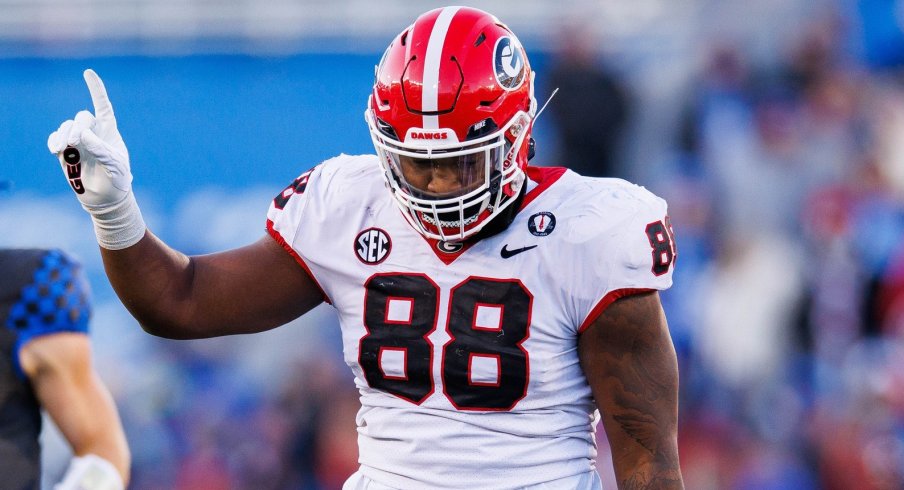Author's Note: In advance of Ohio State's matchup with Georgia in the Peach Bowl on December 31, Film Study will spend each week until then breaking down one aspect of the contest.
- Today: Scouting the Georgia Defense
- December 15: Scouting the Georgia Offense
- December 22: Creating a Game Plan to beat Georgia
- December: 29: Ohio State's Keys to the Game
Seven months ago, the Georgia Bulldogs set a record when 15 players from their championship squad were drafted to NFL teams. Five players were selected in the first round, all of whom played on the defensive side of the ball. And yet, the most talented defender on that team was not among them.
Defensive tackle Jalen Carter (#88) returned for his required third season in Athens and has been a wrecking ball all season long. The 300-pounder moves with a mix of power and athleticism rarely seen at the college level, and anchors a Bulldog defense that once again counts as one of the nation's best.
Despite losing eight starters to the NFL and defensive coordinator Dan Lanning in the offseason, the Dawgs have retained the same basic structure on that side of the ball which carried them to a title one year ago. This year, though, that structure relies heavily on Carter's unique talents to anchor a defensive line that is the bedrock of the top-ranked run defense in the nation this season.
As UGA head coach Kirby Smart has openly admitted at many a coaching clinic over the years, his philosophy is that despite playing in an era in which teams throw the ball more than ever, he still believes in building a strong run defense first. The better a defense is at stopping the run, the more defenders it can then commit to stopping the pass.
Of course, Smart is a longtime disciple of Nick Saban and is well-known for having brought his former boss' legendary system to Georgia. But in the seven seasons since returning home to his alma mater, the Bulldog defense has evolved from an Alabama clone into its own, unique system; one that is built on the success of the defensive line.
While the Bulldogs are still technically a 3-4 defense, they rarely play with all four linebackers on the field at once. Most often, they keep just one, hybrid edge player (called a Jack in their system) on the field at a time, replacing the Sam linebacker for a nickelback known as the Star.
Some of the time, UGA will line up with the Jack lined up like a weakside defensive end and employ the common 4-2-5 structure seen throughout the sport.

But on most occasions, the Dawgs employ an odd front known as Mint in the Saban/Smart world, with the nose tackle lined up directly over the center and two ends (one of which is often the role played by Carter) aligned on the inside shoulders of the offensive tackles.

Unlike the Ohio State defense, which will typically stick with its odd package for an entire series before subbing out for a traditional, four-down look, the Georgia front easily moves back and forth between these two structures. Sometimes, this even happens on the same play, with the entire D-line "stemming" in unison from one look to another, hoping to either draw a false start or disrupt the blocking scheme and leave a defender unblocked.
But the Dawg D-line isn't great at stopping the run because of its alignment before the snap. Instead, they are extremely well-coached and give new meaning to the term block destruction.
The UGA front six doesn't just use effective hand-fighting techniques or focus on getting lower than the blocker, but they actively look to blow up blocking schemes with physicality and aggression. Run concepts featuring pulling blockers (such as Counter or Split-Zone) are often ineffective against this team, as the defenders who are supposed to get kicked out by a pulling guard or tight end instead deliver a violent blow that collapses the entire scheme and forces the running back off his intended path.
But that coaching doesn't end on the practice field, either. Smart expects his staff to not only put the players into the best position to succeed with the play-call but to identify an opponent's specific tendencies. The result is a defense that may get beaten by a creative game plan early in a game but will shut it down the second time a concept is run.
Those familiar with the Saban/Smart systems know that they aren't successful at stopping the run thanks to defensive line play, alone. Rather, their ability to add an extra body to the box without giving up pass coverage integrity is a hallmark of their approach.
This season in Athens, that extra defender has often been freshman free safety Malaki Starks (#24). Considered a top-20 recruit nationally, the local product from nearby Jefferson, Georgia burst onto the scene with an acrobatic interception in week one. But what has earned him a spot on freshman All-America teams is his run-stopping ability.
Many have written about the origins and details of the pattern-matching system pioneered by Saban and now employed by Smart, which allows that extra defender access to the box. I will not try to replicate their efforts here, though I recommend this extremely thorough summary from Cameron Soran for those looking to learn more.
But when expecting a run, the Bulldogs almost always play some version of the 3-deep zone-match system drawn up by Saban and Bill Belichick many years ago. As described in Smart's playbook:
- COVER 3: 3-DEEP ZONE PLAYED WITH RIP/LIZ MATCH, THIS MEANS THAT THE CURL FLAT PLAYERS (THE OUTSIDE UNDERNEATH ZONERS) MATCH VERTICAL ROUTES IN THE SEAMS BUT PASS OFF ALL THE UNDERNEATH ROUTES AND PLAY ZONE. IN COVER 3 THE STRONG SAFETY IS THE DOWN SAFETY – CORNERS ARE PRESS BAIL.
- COVER 6: 3-DEEP ZONE PLAYED WITH RIP/LIZ MATCH, JUST LIKE COVER 3 EXCEPT THE FREE SAFETY IS THE DOWN SAFETY. CORNERS ARE PRESS BAIL.

In layman's terms, that means the defense will initially line up in their assigned zones within the 3-deep, 4-under structure. But if the receiver in that zone takes off vertically down the field, the defender runs with him like it was man coverage. This allows the defense to play with eight defenders near the line of scrimmage to stop the run but still have answers in case the offense tries to throw the ball over the top.
Additionally, the infamous Rip/Liz call (which is just code for Right/Left) allows the defense to start from a 2-deep safety look and flip the scheme to either side of the field based on how the offense lines up prior to the snap.
But while the Dawgs' reliance on this scheme has paid dividends on the ground, opponents have attacked this tendency through the air.
| Year | Yards-per-Game | Rank | Yards-per-Play | Rank | Rush YPG | Rank | Pass YPG | Rank |
|---|---|---|---|---|---|---|---|---|
| 2021 | 267.9 | 2nd | 4.15 | 2nd | 78.87 | 2nd | 189. | 12th |
| 2022 | 292.0 | 9th | 4.77 | 14th | 76.92 | 1st | 215.1 | 51st |
LSU racked up 502 passing yards last weekend in the SEC championship, often attacking the underneath zone defenders with quick passes. Classic, three-step route concepts such as Snag and Spacing (seen below) overloaded one side of the field and gave the Tiger QBs a quick and easy outlet before pressure arrived.
But opponents have also found success this season when trying to take the top off the UGA defense when in this look. On more than one occasion, the safeties have gotten caught looking in the backfield for one beat too long, and strong-armed QBs like Kentucky's Will Levis have made them pay.
Another reason the Dawgs have looked downright average at times against the pass is due to a lack of pass rush. Despite Carter's brilliance, he leads the team with just 3 sacks, and the team as a whole is ranked 77th nationally in sacks per game.
It should be noted that the team's best pure pass rusher, Nolan Smith, is out for the season with a pectoral injury suffered in week eight, but no one has stepped up into his place on the edge, allowing quarterbacks to have more time in the pocket than they did a year ago. When they do 'get home' and sack the QB, it's often thanks to the coverage downfield.
In passing situations, Smart and his staff will switch things up and employ the vaunted Cover 7 system of Quarters coverage that, once again, his mentor made famous. This coverage is not one specific play but rather a family of coverages, all of which can look like man-to-man to the untrained eye.
However, despite all the different types of Cover 7 (such as Box, Mix, Switch, Bracket, etc...) and all the different techniques employed within them (Meg, Cone, Cut, etc...), the system overall is no longer novel. There are countless clinics on YouTube that go into minute detail about how it works and how to beat it, not to mention that many defenses (including Ohio State's with Jim Knowles in charge) run some version of it.
The secret for Saban and Smart, as it always has been, is that they're often employing it with the best players. But when an opponent brings equal talent to the equation (such as LSU's Kayshon Boutte), the outcome is a bit different.
All of this is not to say that the 2022 Georgia defense is pedestrian - far from it. However, those who have not paid close attention may easily be led to believe that the unit which carried Smart to his first national title a year ago has not missed a step, despite losing 73% of its starting lineup to the NFL.
Like many things in this world, the truth lies somewhere in the middle.
Carter is possibly the best player in the entire sport and is capable of wrecking an entire possession on his own. The rest of the front six are no slouches themselves when asked to stop the run, but are not as effective at stopping the pass.
The secondary, meanwhile, is a very talented bunch that features a number of Sunday players...eventually. As we'll discuss in the coming weeks, the Buckeyes will have opportunities to move the football on New Year's Eve, but that doesn't mean those yards will come easily.



